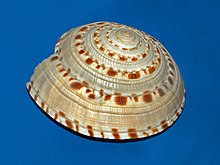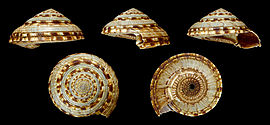Architectonica maxima
| Architectonica maxima | |
|---|---|

| |
| Shell of Architectonica maxima from Japan at the Museo Civico di Storia Naturale di Milano | |
| Scientific classification | |
| Domain: | Eukaryota |
| Kingdom: | Animalia |
| Phylum: | Mollusca |
| Class: | Gastropoda |
| Subclass: | Heterobranchia |
| Family: | Architectonicidae |
| Genus: | Architectonica |
| Species: | A. maxima
|
| Binomial name | |
| Architectonica maxima (Philippi, 1849)
| |
| Synonyms | |
| |
Architectonica maxima, the giant sundial, is a species of sea snail, a marine gastropod mollusk in the family Architectonicidae, which are known as the staircase shells or sundials.[1]

Description[edit]
Architectonica maxima has a shell that reaches 19–82 mm[2] and it is the largest member of the sundial family. This shell is low-spired and quite flattened, with a beaded surface. The shoulder slope is divided into two ribs by a spiral groove.[3] The basic color is cream, with brown spots.
Distribution[edit]
This species can be found in the Indo-Pacific, from East Africa and the Persian Gulf to western Pacific, Japan, eastern Australia, New Zealand, New Caledonia and Hawaii.[2][4][5][3]
Habitat[edit]
Giant sundial is a carnivore deeper water sea snail living on sandy patches and muddy sublittoral bottoms,[3] close to soft corals, at a depth of 10 – 280 m.[5]
References[edit]
- ^ a b Bieler R, Bouchet P, Gofas S, Marshall B, Rosenberg G, La Perna R, Neubauer TA, Sartori AF, Schneider S, Vos C, ter Poorten JJ, Taylor J, Dijkstra H, Finn J, Bank R, Neubert E, Moretzsohn F, Faber M, Houart R, Picton B, Garcia-Alvarez O (eds.). "Architectonica maxima (R. A. Philippi, 1849)". MolluscaBase. World Register of Marine Species.
- ^ a b "Architectonica (Maxima-group) maxima". Gastropods.com. Retrieved 12 January 2019.
- ^ a b c Poutiers, J. M. (1998). "Gastropods". In Carpenter, K. E.; Niem, V. H. (eds.). The living marine resources of the Western Central Pacific Volume 1. Seaweeds, corals, bivalves and gastropods. FAO Species Identification Guide for Fishery Purposes. Vol. 1. Rome: FAO. pp. 637–638. ISBN 92-5-104052-4.
- ^ Discover Life
- ^ a b Sealifebase
